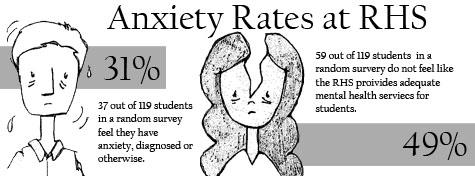RAMBLINGS: Stigmas Attached to Anxiety Need to Be Eliminated to Allow Comfort During School

June 5, 2015
According to the National Institute of Mental Health, eight percent of American teenagers — over three million — have a diagnosed anxiety disorder. You would think such a large number would prompt staff and students alike to take anxiety much more seriously, but you have sadly been deceived.
As someone who has suffered from moderate anxiety since preschool, I can tell you that I rarely look forward to going to school, given that it’s hardly an environment set up for anxiety sufferers like myself to thrive.
Dr. Bonnie Zucker, a private-practice psychologist specializing in anxiety disorders, said, “The overriding principle [behind treating anxiety] is that you have to face your fears to overcome them a�� Learning positive self-talk and how to challenge common thinking errors will make it easier for someone to face their fears.” Unfortunately, this is easier said than done.
The thought of asking teachers for help sometimes gets my heart racing. My chest gets tight when a teacher assigns a group project and almost every one of my peers is begging them to let them choose their partners, because I know I will be standing alone at the end of the partner selection, the object of the teacher’s pity and perhaps other students’ harsh judgment.
And making new friends, something everyone else seems to be able to do without lifting a finger? To quote Vizzini from “The Princess Bride,” “inconceivable!”
Most teachers that I meet do not seem to understand that school is a constant uphill battle for people like me with anxiety. They probably have no idea that activities other people might consider trivial could send me into several minutes of difficulty breathing and abdominal cramps, courtesy of my heightened fight-or-flight response. I fear that they will give me looks of surprise and disappointment when I show up late when I need to ask for an extension because I literally had to work up the courage to do so.
Even worse than feeling alone and unsupported at school, students with anxiety might experience frequent invalidation of their mental illness, or witness their peers making fun of or trivializing their problems.
A few months ago, I heard a classmate joking about having a panic attack before a short presentation. If it hadn’t been for — guess what — my anxiety, I would have told him that panic attacks are no laughing matter. I should know: I had an hour-long panic attack over a written commentary in English class last year.
What can the school do to help students with anxiety, you might ask? We could start by hiring counselors who specialize in anxiety disorders, or spreading awareness of the presence of our school psychologist, who works to create a safe and supportive school environment. Teachers could also be asked to create calendars of assignments and tests in advance to prevent students with and without anxiety disorders from feeling overwhelmed.
However, more importantly than any of the above actions, we need to end the stigma surrounding anxiety and other mental illnesses. The first step to solving a problem is admitting that you have one, but how can someone come forward about their anxiety if they have a realistic fear of being judged and viewed as “broken” after doing so? The insensitive jokes need to stop, and acceptance needs to start.



